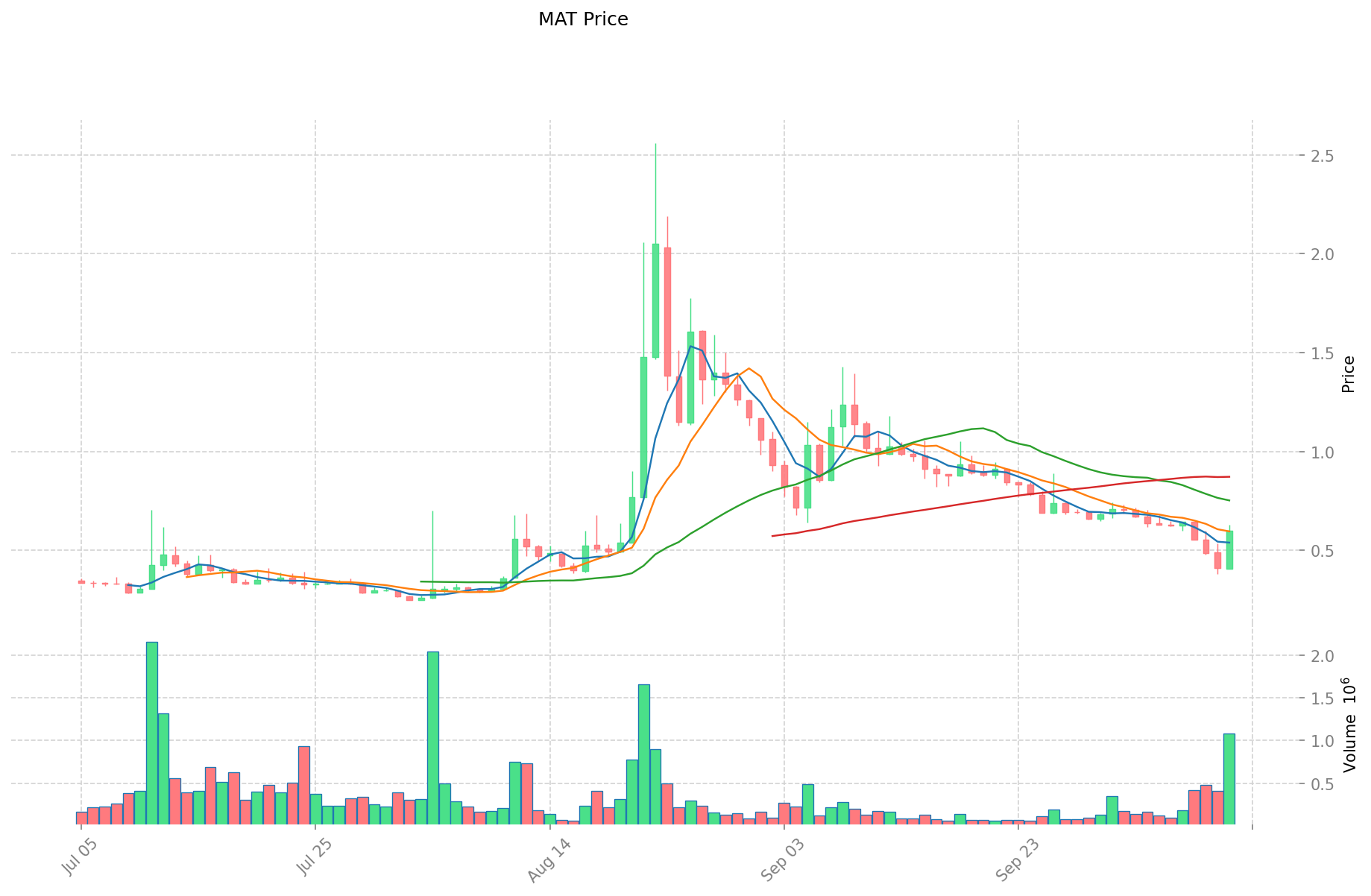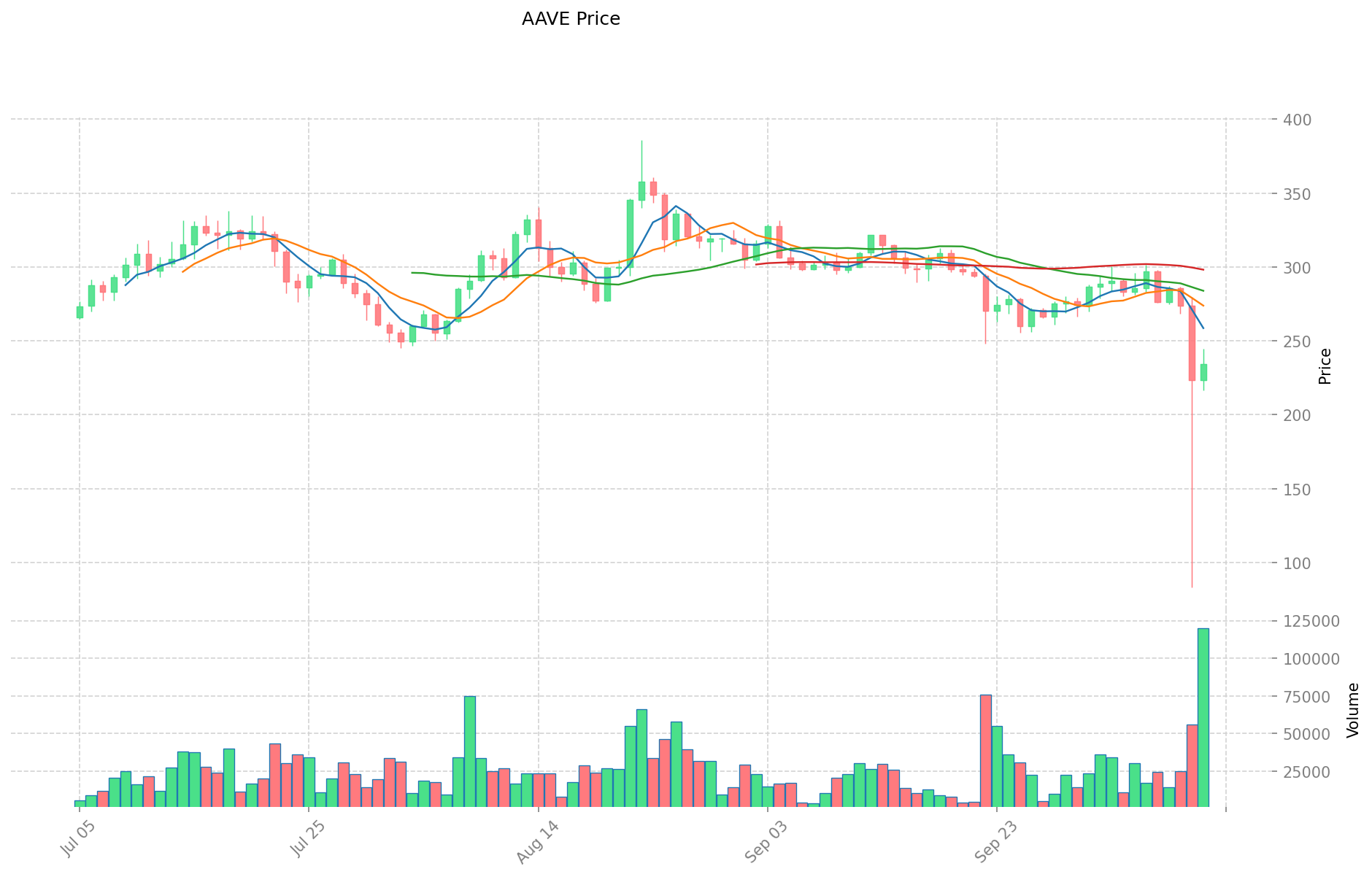MAT vs AAVE: Comparing Lending Protocols in DeFi Ecosystems
Introduction: MAT vs AAVE Investment Comparison
In the cryptocurrency market, the comparison between Matchain (MAT) vs AAVE (AAVE) has always been a topic that investors can't ignore. The two not only show significant differences in market cap ranking, application scenarios, and price performance, but also represent different positioning in crypto assets.
Matchain (MAT): Since its launch, it has gained market recognition for its AI chain for ID & data sovereignty.
AAVE (AAVE): Since its inception in 2020, it has been hailed as a leading decentralized lending protocol, providing deposit and lending services to users.
This article will comprehensively analyze the investment value comparison between MAT and AAVE, focusing on historical price trends, supply mechanisms, institutional adoption, technical ecosystems, and future predictions, and attempt to answer the question that investors care about most:
"Which is the better buy right now?" Here is the report section based on the provided template and information:
I. Price History Comparison and Current Market Status
MAT and AAVE Historical Price Trends
- 2025: MAT reached an all-time high of $7.38 on June 19, 2025.
- 2021: AAVE hit its record high of $661.69 on May 19, 2021, during the bull market.
- Comparative analysis: In the recent market cycle, MAT dropped from its peak of $7.38 to a low of $0.2476, while AAVE has shown more stability, currently trading at $233 compared to its all-time high.
Current Market Situation (2025-10-12)
- MAT current price: $0.5803
- AAVE current price: $233
- 24-hour trading volume: MAT $599,556.68 vs AAVE $27,373,678.27
- Market Sentiment Index (Fear & Greed Index): 24 (Extreme Fear)
Click to view real-time prices:
- Check MAT current price Market Price
- Check AAVE current price Market Price


Investment Value Analysis: MAT vs AAVE
I. Investment Value Factors for AAVE
Market Position and Protocol Health
- AAVE maintains a leading position in the DeFi lending sector
- Protocol revenue significantly exceeds operational expenses
- Strong financial reserves primarily held in ETH and stablecoins
Economic Model and Value Capture
- Recent AAVEnomics update proposal introduces profit distribution to AAVE stakers
- Protocol implementing buyback mechanism using surplus profits
- Reduced selling pressure through restructuring of token emissions
Technical Innovation
- Evolution through multiple versions (V1-V4) with continuous improvements
- Flash loans pioneered as a revolutionary DeFi primitive
- Introduction of the Umbrella security system replacing the original safety module
GHO Stablecoin Integration
- Native stablecoin offering direct revenue to AAVE DAO
- Linear revenue growth potential as GHO adoption scales
- Introduction of "Anti-GHO" functionality for AAVE stakers
II. Core Factors Affecting Investment Value of MAT vs AAVE
Supply Mechanism Comparison (Tokenomics)
- AAVE: Becoming more deflationary with new buyback program; total supply of approximately 16 million tokens with significant portion locked in security modules
- MAT: Limited information available in provided resources
- 📌 Historical Pattern: AAVE's value has been historically tied to DeFi market cycles and protocol revenue
Institutional Adoption and Market Applications
- Institutional Holdings: AAVE has demonstrated strong institutional appeal with over $275 million worth of tokens staked in security modules
- Enterprise Adoption: AAVE is widely integrated across the DeFi ecosystem as fundamental financial infrastructure
- Regulatory Stance: Cryptocurrency prices including AAVE can be significantly affected by financial, regulatory, and political events
Technical Development and Ecosystem Building
- AAVE Technical Upgrades: Recent implementation of the Umbrella security system and unified liquidity layer in V4
- AAVE Ecosystem Development: Continuous evolution from ETHLend to AAVE V4, with modular security systems similar to Eigenlayer's AVS model
- Ecosystem Comparison: AAVE has established itself as a core DeFi lending platform with cross-chain capabilities
Macroeconomic and Market Cycles
- Inflation Performance: DeFi platforms like AAVE can serve as alternative financial systems during periods of traditional financial instability
- Monetary Policy Impact: Interest rates and overall crypto market conditions significantly influence DeFi lending platforms
- Geopolitical Factors: DeFi adoption can be driven by financial sovereignty needs across different jurisdictions
III. 2025-2030 Price Prediction: MAT vs AAVE
Short-term Prediction (2025)
- MAT: Conservative $0.39-$0.56 | Optimistic $0.56-$0.71
- AAVE: Conservative $124.76-$231.03 | Optimistic $231.03-$265.68
Mid-term Prediction (2027)
- MAT may enter a growth phase, with prices estimated at $0.37-$0.72
- AAVE may enter a bullish market, with prices estimated at $190.94-$394.19
- Key drivers: Institutional capital inflow, ETF, ecosystem development
Long-term Prediction (2030)
- MAT: Base scenario $0.78-$0.81 | Optimistic scenario $0.81-$0.85
- AAVE: Base scenario $311.25-$438.37 | Optimistic scenario $438.37-$477.83
Disclaimer: This analysis is based on historical data and market projections. Cryptocurrency markets are highly volatile and unpredictable. This information should not be considered as financial advice. Always conduct your own research before making investment decisions.
MAT:
| 年份 | 预测最高价 | 预测平均价格 | 预测最低价 | 涨跌幅 |
|---|---|---|---|---|
| 2025 | 0.709254 | 0.5629 | 0.388401 | -2 |
| 2026 | 0.74421009 | 0.636077 | 0.45161467 | 9 |
| 2027 | 0.7177492868 | 0.690143545 | 0.3726775143 | 18 |
| 2028 | 0.809538378285 | 0.7039464159 | 0.619472845992 | 21 |
| 2029 | 0.870253756656375 | 0.7567423970925 | 0.68106815738325 | 30 |
| 2030 | 0.846037999949415 | 0.813498076874437 | 0.78095815379946 | 40 |
AAVE:
| 年份 | 预测最高价 | 预测平均价格 | 预测最低价 | 涨跌幅 |
|---|---|---|---|---|
| 2025 | 265.6845 | 231.03 | 124.7562 | 0 |
| 2026 | 367.56873 | 248.35725 | 144.047205 | 7 |
| 2027 | 394.1926272 | 307.96299 | 190.9370538 | 32 |
| 2028 | 442.358038836 | 351.0778086 | 298.41613731 | 51 |
| 2029 | 480.02868769878 | 396.717923718 | 265.80100889106 | 71 |
| 2030 | 477.8269032221451 | 438.37330570839 | 311.2450470529569 | 88 |
IV. Investment Strategy Comparison: MAT vs AAVE
Long-term vs Short-term Investment Strategy
- MAT: Suitable for investors interested in AI and data sovereignty potential
- AAVE: Suitable for investors seeking DeFi exposure and protocol revenue
Risk Management and Asset Allocation
- Conservative investors: MAT: 20% vs AAVE: 80%
- Aggressive investors: MAT: 40% vs AAVE: 60%
- Hedging tools: Stablecoin allocation, options, cross-token portfolios
V. Potential Risk Comparison
Market Risk
- MAT: Higher volatility, less market data available
- AAVE: Dependent on overall DeFi market health
Technical Risk
- MAT: Scalability, network stability
- AAVE: Smart contract vulnerabilities, flash loan exploitation
Regulatory Risk
- Global regulatory policies may impact both differently, with AAVE potentially facing more scrutiny as a DeFi lending platform
VI. Conclusion: Which Is the Better Buy?
📌 Investment Value Summary:
- MAT advantages: Potential growth in AI and data sovereignty sectors
- AAVE advantages: Established DeFi protocol, consistent revenue generation, ongoing technical innovations
✅ Investment Advice:
- New investors: Consider a higher allocation to AAVE for its established market position
- Experienced investors: Balanced portfolio with both MAT and AAVE, adjusting based on risk tolerance
- Institutional investors: Focus on AAVE for its institutional-grade infrastructure and potential for protocol revenue sharing
⚠️ Risk Warning: The cryptocurrency market is highly volatile. This article does not constitute investment advice. None
VII. FAQ
Q1: What are the main differences between MAT and AAVE? A: MAT focuses on AI and data sovereignty, while AAVE is a leading DeFi lending protocol. AAVE has a more established market position and consistent revenue generation, whereas MAT represents potential growth in emerging sectors.
Q2: Which token has shown better price performance historically? A: AAVE has demonstrated more price stability compared to MAT. While MAT reached an all-time high of $7.38 in 2025, it has since dropped significantly. AAVE, despite fluctuations, has maintained a higher price point relative to its all-time high.
Q3: How do the tokenomics of MAT and AAVE compare? A: AAVE is becoming more deflationary with its new buyback program and has a total supply of approximately 16 million tokens. Information on MAT's tokenomics is limited in the provided resources.
Q4: What are the key factors affecting the investment value of these tokens? A: Key factors include supply mechanisms, institutional adoption, technical development, ecosystem building, and macroeconomic conditions. AAVE has shown strong institutional appeal and is widely integrated across the DeFi ecosystem.
Q5: What are the projected price ranges for MAT and AAVE in 2030? A: Based on the provided predictions, MAT's price range for 2030 is estimated at $0.78-$0.85, while AAVE's range is projected to be $311.25-$477.83.
Q6: How should investors approach risk management when investing in MAT and AAVE? A: Conservative investors might consider allocating 20% to MAT and 80% to AAVE, while aggressive investors might opt for a 40% MAT to 60% AAVE split. Hedging tools such as stablecoin allocation, options, and cross-token portfolios are recommended.
Q7: What are the potential risks associated with investing in MAT and AAVE? A: Risks include market volatility, technical vulnerabilities, and regulatory challenges. MAT may face higher volatility and scalability issues, while AAVE could be impacted by smart contract vulnerabilities and increased regulatory scrutiny as a DeFi platform.
Q8: Which token might be more suitable for different types of investors? A: New investors may consider a higher allocation to AAVE for its established market position. Experienced investors might opt for a balanced portfolio of both tokens. Institutional investors may focus more on AAVE due to its institutional-grade infrastructure and potential for protocol revenue sharing.
Share
Content